Stories of Puget Sound Recovery:
Kids Kick Asphalt Out of the School Yard for Clean Water
Kids playing on the new grass play field at Holy Rosary Bilingual Academy in Tacoma. Photo Credit: Tim Rue
For 50 years, students scraped their knees during recess at Holy Rosary Bilingual Academy (Holy Rosary). Students at the Tacoma, WA school played on a vast sheet of asphalt adjacent to I-5, with the resulting bumps, bruises, and Band-Aids becoming common accessories and frequent concerns of parents. Today, that area is unrecognizable to past generations of Holy Rosary students after the school converted the asphalt into a verdant green space with 70 trees and a grass-filled soccer field.
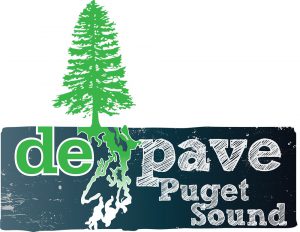 This transformation is due to a recently completed depave effort that began in 2018. Depave projects entail removing asphalt from overly paved urban areas and replacing it with vegetation to create community green spaces. Depave, a Portland, Oregon-based non-profit organization, was the first to bring community partners together to implement this type of greening project; Depave Puget Sound is a local offshoot that convenes public and private agencies and community members from around the Sound to complete depave projects. This particular project was made possible under the guidance of the Pierce Conservation District, which works to conserve natural resources throughout Pierce County via collaborative community efforts.
This transformation is due to a recently completed depave effort that began in 2018. Depave projects entail removing asphalt from overly paved urban areas and replacing it with vegetation to create community green spaces. Depave, a Portland, Oregon-based non-profit organization, was the first to bring community partners together to implement this type of greening project; Depave Puget Sound is a local offshoot that convenes public and private agencies and community members from around the Sound to complete depave projects. This particular project was made possible under the guidance of the Pierce Conservation District, which works to conserve natural resources throughout Pierce County via collaborative community efforts.
Depave projects bring a wealth of environmental and community benefits, but perhaps the largest benefit is stormwater pollution prevention. As rain hits the pavement, it collects all manner of toxic pollutants—from oil and grease dripped from cars to pesticides and pet waste—and flows into streams and rivers that make their way into Puget Sound. More pavement leads to more polluted stormwater. Pollution in the area’s water sources is a significant contributing factor to some of the Puget Sound’s most prominent ecological problems, including declining salmon populations and the poor health of the critically endangered Southern Resident killer whales.
However, depave is still not yet a well-known concept. For projects like Holy Rosary’s to get off the ground, a community champion is essential.
Enter Carrie Hernandez.
A Seed of an Idea
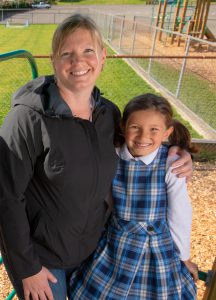
Hernandez is the mother of five children, the youngest two of whom were enrolled at Holy Rosary starting at the PreK3 level, with the older of the two currently in second grade. She and her husband were formerly in the military and moved to the Puget Sound region 14 years ago. Since then, she has worked for a selection of nonprofits and has done community volunteering focused on restoring habitat and improving water quality. Professionally, she’s intimately familiar with the negative effects of stormwater as a manager with the Stormwater Community of Interest at the Puyallup Watershed Initiative, where she brings together individuals from organizations, businesses, and agencies in the Puyallup River watershed to rethink how the community approaches stormwater management.
“When I started hearing about the Conservation District’s depave program, I was at a meeting where Conservation District representatives were looking for depave sites [to nominate] and I thought ‘oh my gosh, what a perfect solution to the problem that I’m seeing at Holy Rosary’,” said Hernandez. After seeing her own kids come home with scrapes, she thought, “they need to get rid of all of that asphalt for the kids when they have P.E. and recess.”
That’s when she reached out to Katie Dempsey, the Principal at Holy Rosary, to connect her with the Conservation District to explore the possibility of nominating the site for a depave project. The two found themselves with similar priorities, with Dempsey concerned about the safety issue that the blacktop presented and eager to create a green space that gave faculty a chance to use the space as an environmental education opportunity for the students.
“I joked that if there’s nothing else I accomplish here except creating a soccer field for the kids, that I would be successful,” mentions Dempsey, who noted that soccer is the most popular sport among the students. After securing permission from the parish to remove the asphalt and replace it with plants and trees, Dempsey and Hernandez worked with the Conservation District to secure funding for the project.
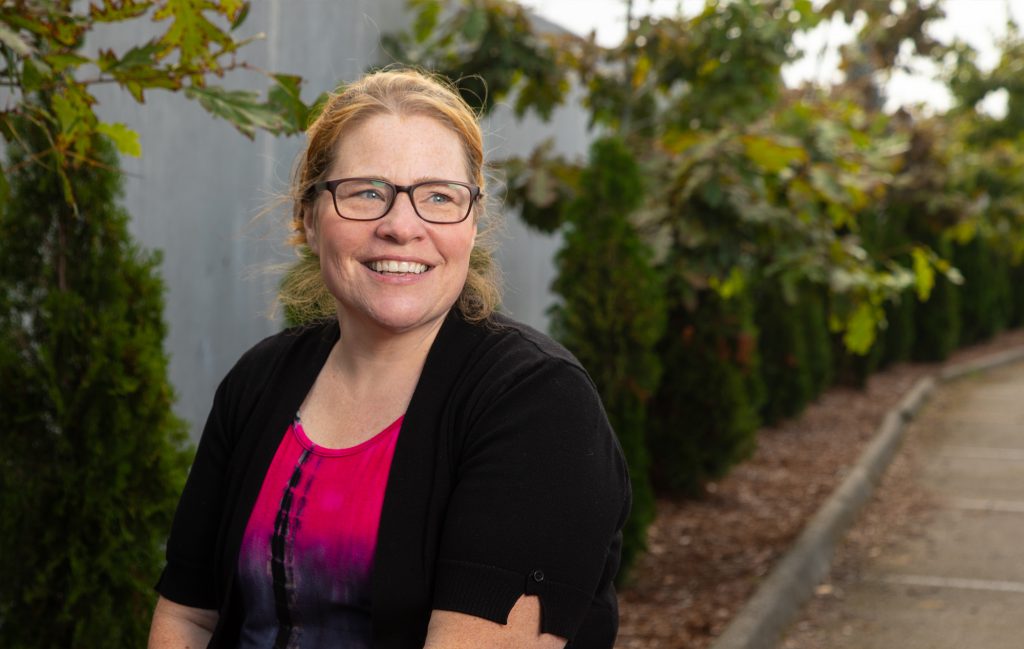
The National Estuary Program (under the U.S. Environmental Protection Agency), The Nature Conservancy, and The Rose Foundation, which supports grassroots initiatives to promote stewardship of the environment, funded the bulk of the project, which began in fall 2018. By the spring of 2019, dozens of volunteers—including Holy Rosary students and their parents, volunteers recruited by the Conservation District, and members of the Veterans Conservation Corps—had manually hoisted thousands of pounds of asphalt into dumpsters for removal and recycling.
Planting A Greener Future
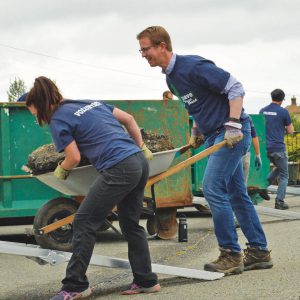
Despite the challenge of doing that heavy lifting, “we [were] creating this vision together, putting our sweat into it,” Dempsey said. “Once people got into it, I think they got a sense of accomplishment; it brought our community together. You have people of all ethnicities, religions, and socioeconomic levels out there together.” Members of the community coming together to complete this project is a prime example of Sound Stewardship, one of the Puget Sound Vital Signs that measures ecosystem health and progress towards Puget Sound recovery goals. In a 2018 survey, 25% of residents in the Pierce County area stated that they frequently engage in stewardship activities that are personally meaningful to them and that they believe will benefit the environment.
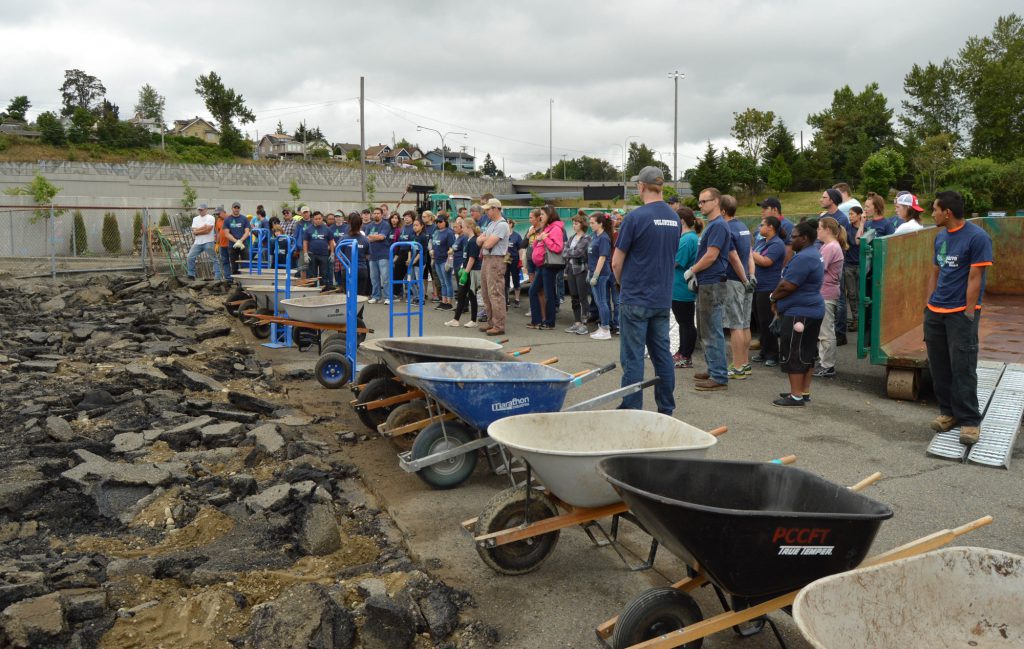
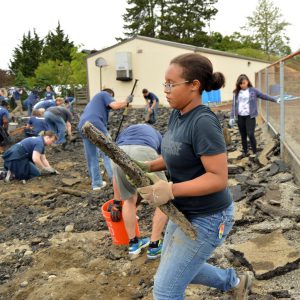
Once the asphalt was removed, the student and parent volunteers began transforming the space into a valuable community asset that fit Holy Rosary’s vision. Dempsey worked closely with the Conservation District to design the green space according to the school’s needs and praised the partnership for its flexibility and encouragement: “Pierce Conservation District has unlimited vision, they want you to be able to dream big and change the environment, reduce runoff, and provide play areas for kids in the community.” After weeks of anticipation while the finishing touches were being put on the greening effort, Holy Rosary opened the soccer field and new playground—much to the delight of the students and their families. Parishioners at the church shared with Dempsey how excited they were about the beautification of the campus.
“The kids really enjoy being outside in the space. I hear of fewer instances of tripping and slipping on concrete and getting hurt. Parents that I’ve talked to appreciate the tree barrier at the back of the playground—it feels safer for the kids to be playing there,” says Hernandez. “There’s a call for even more outdoor learning space and more green space to be put in. I’ve heard parents joke about getting the church to change their parking lot too, since they’re adjacent to each other. It’s a positive forward movement of ‘we have plants and trees; how do we get more?’”
The depave project will be a source of lasting memories for the Holy Rosary families that volunteered to bring it to life. “It was more impactful to have families and their kids out working and planting. I volunteer at the school sometimes and the kids say, ‘I planted this tree with my mom, with my dad, we helped remove that concrete.’ There was such a community buy-in piece,” notes Hernandez as she reflects on the value of collaboration in the project. “I propose depave for everything! I love the program.”
Fun for Kids, Great for the Environment
The depave project should help realize significant environmental benefits. On average, in the Puget Sound area, every 10,000 square feet of asphalt generates 240,000 gallons of stormwater runoff each year. Removing the 15,000 square feet of asphalt from Holy Rosary’s parking lot and playground area prevents approximately 360,000 gallons of polluted stormwater from entering local waterways and instead nourishes a landscape designed to fit the school’s needs.
“If we can do that at scale, just imagine what the Puget Sound would be like if hundreds of thousands of square feet of asphalt were transformed into greenscape. Not only does the stormwater benefit, just think how much better of a place it would be to live,” reflects Allan Warren, the Communication and Development Director at Pierce Conservation District, who was responsible for writing the winning grant application that funded the Holy Rosary depave project.
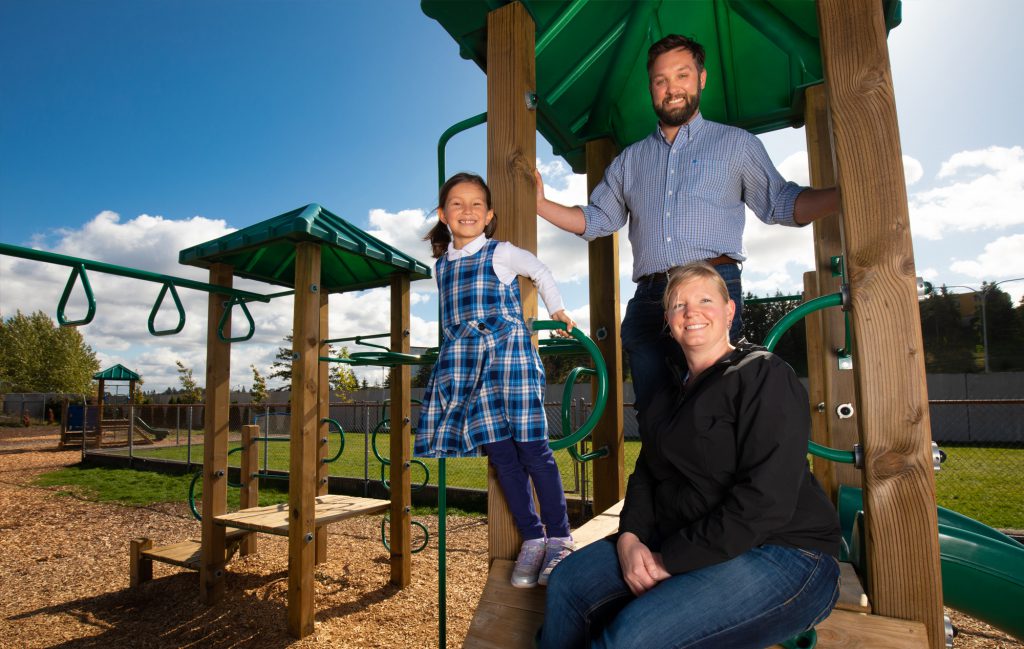
Warren acknowledges that it is difficult to educate members of the Pierce County community on the importance of stormwater management; he sees depave as a different way to tell the story while mobilizing people to take ownership of improving their communities. “The power of reframing a story…so much of what we work on in the conservation field is about problems. When you present people with a solution, they jump on board energetically. When you work with communities to bring that solution to bear and complete a project, the sense of gratitude and accomplishment is incredible. That’s what depave is to me. It’s not a silver bullet, it’s not going to solve our stormwater problems, but it’s a tool that will engage people in stormwater issues like nothing else can.”
Warren hopes that the Holy Rosary project can be a standard-bearer for depave efforts throughout the Puget Sound region. He’s developing a comprehensive, step-by-step toolkit that can be used both by community advocates and stormwater professionals to implement depave projects in all sorts of applications, from parking lots to storefronts. The Holy Rosary project and the toolkit to help others replicate depave projects are both part of the Action Agenda for Puget Sound, the comprehensive recovery plan which incorporates regional strategies and specific actions to restore and protect Puget Sound.
“Let’s spread the message that this should be happening everywhere,” Warren says. “Every jurisdiction across Puget Sound should be doing a depave project, whether big or small. Everybody has pavement that doesn’t need to be there and can become something that is not only a stormwater project but is beneficial and beautifies communities.”
Vital Sign Connections
Runoff, as it flows over paved surfaces, picks up and carries urban pollutants to local streams and rivers. Depave is developing tools that local Puget Sound communities can use to transform hard pavement to green space where rain can soak into the ground instead of carrying pollution into Puget Sound waterways.
As land is developed for communities and roads, forest cover and natural landscapes are lost. Trees and forests provide habitat for wildlife, protect rivers and streams, and capture toxics before they pollute our waters. The Depave project brings trees to urban landscapes.
People who live in Puget Sound overwhelmingly agree that they feel a sense of attachment to and pride in the Puget Sound region. Volunteers working to restore green space in this story demonstrate a positive connection and a strong sense of stewardship for our natural environment.
Action Agenda Connections
The Action Agenda—the Puget Sound Partnership’s regional plan for protecting and recovering Puget Sound—recognizes stormwater as the largest source of water pollution and describes the importance of retaining and filtering polluted runoff so that it doesn’t flow directly into streams, rivers, or the Sound.
The 2016-2018 Action Agenda included a priority Near Team Action (NTA) to create guidance on conducting Depave projects. The Depave project at the Holy Rosary School in Tacoma, featured here, is one of three planned projects outlined in the NTA.
Find out more about proposed and active Puget Sound protection and restoration projects in the Action Agenda Tracker.
More Information
10,000 square feet of asphalt is no match for army of de-paving volunteers
Depave Puget Sound Removes 15,000 Square Feet of Pavement at Holy Rosary Church

